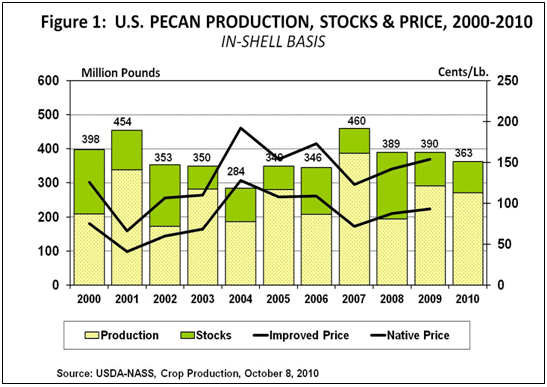Vol. 26, Issue 28, October 8, 2010 – PDF version
Jose G. Peña, Texas AgriLife Extension Economist-Management
The pecan market opened to excellent price bids as demand is strong, especially export demand from China and the estimate of available supplies is down. USDA’s initial estimate of pecan production for the 2010/11 season, released on October 8, 2010, at 271.3 million pounds is down 7.0 percent from 291.8 million pounds produced last year, but up 77.2 million pounds from 194.1 million pounds produced during 2008’s off-year. (see table 1). Pecan prices during the 2009/10 season were the 3rd highest on record, behind 2004 and 2006. USDA’s initial estimate for the 2010 crop indicates that 220.3 million pounds or 81 percent of the 271.3 million pound total will be improved varieties, while native and seedling varieties, at 51.0 million pounds, will make up the remaining 19 percent.
The market opened to prices of $4.00-$4.50/point for good quality pecans for the gift pack/fund market. Exports to China have increased substantially during the past four years, putting upward pressure on market prices. About 88.6 million pounds (in-shell) of pecans were exported to China during 2009.
Carry-in stocks of about 92 million pounds, as of the end of September 2010, are down about five million pounds (down 6.1 percent) from carry-in stocks of about 98 million pounds a year ago at this same time. The production estimate, together with the estimate of carry-in stocks brings the estimate of total U.S. supplies to about 363.2 million pounds, down about 26.5 million pounds (down 7.3 percent) from supplies of about 389.7 pounds at this same time, a year ago, and 26.2 million pounds below total supplies of about 389.4 million pounds at this same time in 2008, as China was increasing its demand for U.S. pecans (See Figure 1).
Production in Mexico Down
In addition, potential imports from Mexico may be lower than last year as Mexico is expecting an off-year crop in 2010. According to USDA-Foreign Agricultural Service (FAS) Tree Nuts Annual Gain Report for Mexico, released on September 14, 2010, pecan production in Mexico for the marketing year (Oct.-Sept.) 2010/11 is forecast at 165 million pounds (75,000 metric tons), down 35 percent from an estimated 253 million pounds (115,000 MT) produced in MY 2009/10, due primarily to the alternate bearing cycle of tree nuts. According to the report, exports from Mexico for MY 2010/11 are forecast at 129.8 million pounds (59,000 MT), in-shell basis, substantially lower than last year due to fewer domestic supplies. The U.S. remains the main export market for Mexican pecans since it maintains attractive prices and offers year-round demand. Generally, the highest quality pecan nuts are exported to the U.S. Last year, about 141 million pounds were exported to the U.S.
U.S. pecan supplies should be lower than last year and continued strong demand from the China region is expected to place upward market pressure which will be similar to last year. The problem this year may not be the market. Supplies may be tight to meet last year’s domestic and export demand, especially export demand from China.
Tree Nuts
Meanwhile, the pecan industry can expect stiff competition from an expected record crop of U.S. almonds and walnuts.
USDA’s initial total tree nut forecast for 2010/11 season at 3.4 billion pounds, is up 11.2 percent from last year’s crop of 3.07 billion pounds (See Figure 2). Almond production, forecast at a record 1.65 billion pounds (shelled basis), if realized, will be 17.0 percent higher than 1.41 billion pounds produced last year and accounts for the large portion of the forecast. The estimate of walnut production at a record 1.0 billion pounds will be up 16.7 percent from 874 million pounds produced last year. Almond production will account for about 48 percent of total U.S. tree nut production and together with walnuts will account for about 78 percent of total U.S. tree nut production. Pecans only comprise about eight percent of total U.S. tree nut crop.
Despite increasingly bigger tree nut crops each year, prices for most U.S. tree nuts have been climbing throughout much the 2000s due to strong world demand.



